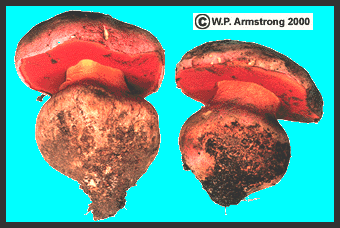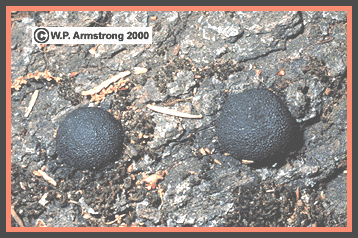|
Satan's Boletus
| Wayne's Word Noteworthy Plant For February 1998 |
Nifty Fungi From Palomar Mountain
Two Fungi That Resemble A Delicious Mushroom
and A Ball-Shaped Piece of Charcoal
Satan's Bolete Mushroom
On a recent field trip to Palomar Mountain, two very unusual species of fungi were discovered by an inquisitive student. One species looked very much like an edible mushroom in the genus Boletus. Although this genus contains some of the most delicious mushrooms on earth, our discovery turned out to be a bolete that could potentially make you sick. The other fungus looked like a black, charred insect gall or a ball-shaped piece of charcoal.
Palomar Mountain is a beautiful 6,000 foot (1800 m) mountain in the Peninsular Ranges of southern California. It is forested with ponderosa pine (Pinus ponderosa), Jeffrey pine (P. jeffreyi), Coulter pine (P. coulteri), white fir (Abies concolor), big-cone Douglas fir (Pseudotsuga macrocarpa) and incense cedar (Calocedrus decurrens). The dense conifer forests are interspersed with mountain meadows and oak woodlands, dissected by numerous permanent and ephemeral creeks and streams. Unlike other southern California mountain ranges to the north, Palomar Mountain has a higher annual rainfall of 30 to 60 inches (76 to 150 cm) or more. One of the reasons for this higher precipitation is its location in San Diego County, where it receives summer tropical storms from Mexico and the Gulf of California. The fungi discussed in this Noteworthy Plants grow under the deciduous California black oaks (Quercus kellogii) within the conifer forests.
The genus Boletus contains many large mushroom species, some of which are exquisitely delicious. In fact, one of the prized mushrooms in this genus is B. edulis. Bolete mushrooms are distinctive compared with gill mushrooms. The underside of the umbrella-like cap is porous like a fine sponge. It does not have the partitions (called gills) of gill mushrooms. The underside of the cap on our species was bright pinkish-red, especially vivid on young specimens.
Mr. WOLFFIA Overindulging On A Fresh Bolete Harvest
HIPPER After Consuming A Poisonous Gill Mushroom
It is always best to carefully identify a mushroom with a good field guide before attempting any gourmet dishes with it. If you don't understand the terminology, then enrol in a mushroom identification field course at your local college. Using the excellent dichotomous keys and illustrations in Mushrooms Demystified by David Arora, our lovely mushroom turned out to be "Satan's Bolete" (Boletus satanas). According to David Arora, this species is poisonous, at least if eaten raw. It causes vomiting, diarrhea, severe cramps, and a general unpleasantness that may spoil your happy outing in the forest. Thorough cooking reputedly destroys the toxins, and some people apparently eat it with impunity; however, Arora does not recommend it when so many more delectable and less dangerous mushrooms abound. The common name of "Satan's Bolete" may give you a clue about its palatability. It is doubtful that Satan had anything to do with the distribution of this interesting mushroom on Palomar Mountain.
Satan's bolete is quite distinctive with its large, bulbous base which may be almost as large in diameter as the umbrella-like cap. The pores on the underside of the cap have red rims and yellow tubes. The thousands of red-rimmed pores collectively produce a vivid pinkish-red color on young specimens. The pores readily bruise when touched, and rapidly turn bluish-black. On older mushrooms the undersides become reddish-brown. The stalk also has a distinctly reticulate (netlike) pattern of reddish veins.

Satan's bolete (Boletus satanas).
This is a large mushroom, with caps up to 12 inches (30 cm) in diameter. In fact, they are so large and meaty that they look like a mushroom gourmet's delight. On Palomar Mountain, you can actually sniff their presence if you happen to be near a large population. This is especially true when they start getting old and ripe (rotten). They typically grow in the thick duff and leaf litter under deciduous California black oaks (Quercus kelloggii), and are easily spotted where the leaves become pushed up into mounds. When the leaves are brushed away, the huge cap is revealed. Because of fine root strands attached to the bulbous base, they appear to be connected to the root systems of the oaks in a symbiotic mycorrhizal association.
See Another Species Of Bolete Mushroom (Boletus edulis)
Mycorrhizal Soil Fungi In WAYNE'S WORD Fungus Article
Carbon Balls Fungus
The second species of fungus is appropriately named "carbon balls." In fact, it looks and feels like a spherical (ball-shaped) piece of charcoal. It is very brittle and even cracks into pieces like charcoal. The species on Palomar Mountain appears to be Daldinia grandis, although it looks very similar to another species of the eastern United States, D. concentrica. The interior of the spore-bearing, fruiting body is composed of clearly visible concentric layers or zones. This fungus commonly grows by itself or in groups of several dozen on the bark of dead logs, especially oaks. On Palomar Mountain it seems very fond of California black oaks (Quercus kelloggii). Because of their spherical shape, dry texture and tight attachment on oak logs, we originally thought they were some type of insect gall. However, they did not contain any insect larvae as in typical oak galls.

Carbon balls (Daldinia grandis) on the bark of a black oak log.
Carbon balls are truly bizarre organisms that certainly do not resemble a typical fungus. They are clearly inedible--in fact, eating one would be like biting into a lump of coal. According to David Arora (1986), they also have the peculiar common names of "crampballs" and "King Alfred's cakes." The nickname "crampballs" is attributed to the old folk belief that carrying one under your armpits would cure cramps. It is very doubtful that this remedy has any medicinal merit. It is about as effective as carrying a sea bean in your back pocket as a treatment for hemorrhoids (See Noteworthy Plants May 1996). If you have cramps, we suggest that you ask your pharmacist or herbologist for a more proven remedy. If all this fails, see your physician. Carbon balls could possibly be used as a substitute for charcoal, however we haven't verified this.

|
Close-up view of several carbon balls (Daldinia grandis). The bumpy surface is caused by thousands of pimple-like, spore-bearing perithecia all packed together.
|
Close examination of a carbon ball reveals that the surface is composed of minute bumps or pimples. These are actually the tops of tiny spore bearing structures called perithecia which are embedded in the surface. Each flask-like perithecia contains an internal chamber or cavity bearing numerous sac-like asci, each with 8 ascospores. Because of the type of spore-bearing structures, this fungus belongs to the large and diverse fungal class Ascomycetes, along with most of the lichen species on Palomar Mountain. In fact, some pyrenocarpous lichens, such as Verrucaria, also have pimple-like perithecia on the surface of their thallus.
 See Illustration Of A Lichen Perithecium See Illustration Of A Lichen Perithecium
 See Pimple-Like Perithecia On Crustose Lichen See Pimple-Like Perithecia On Crustose Lichen
According to C.M. Cristensen (Common Fleshy Fungi, 1974), fruiting bodies of Daldinia concentrica taken into the laboratory and kept in moderately humid air will discharge large numbers of black ascospores resembling coal dust. The black spores are usually released at night, every night for a week or more.
An Excellent Field Guide To The Fungi
Arora, David. 1986. Mushrooms Demystified (Second Edition).
Ten Speed Press, Berkeley, California.
|
|


